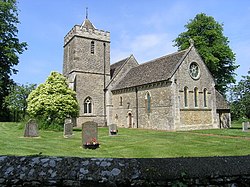Stoke Lyne
| Stoke Lyne | |
| Oxfordshire | |
|---|---|
 St Peter's, Stoke Lyne | |
| Location | |
| Grid reference: | SP567282 |
| Location: | 51°57’0"N, 1°10’34"W |
| Data | |
| Population: | 418 (2011) |
| Post town: | Bicester |
| Postcode: | OX27 |
| Dialling code: | 01869 |
| Local Government | |
| Council: | Cherwell |
| Parliamentary constituency: |
Banbury |
Stoke Lyne is a tiny village four miles north of Bicester in Oxfordshire.
The village has one church and one pub, the Peyton Arms.
Name
The name Stoke Lyne is first attested, simply as Stoches, in the Domesday Book of 1086: it is a very generic name, from the Old English word stoc, used of a secondary settlement or outlying farmstead. This was later disambiguated: the form Stoke del Isle ('Stoke of the Del Isle family') is attested in 1328, and in the Latinised form Stoke Insula already in 1316. In the early fifteenth century, the estate was bought by William Lynde, and the name came to be disambiguated through the addition of his family's name. This is first attested in 1526 in the form Stokelynde; the present-day form is first attested as Stoke-lyne in 1658.[1]
Battle of Fethan leag
According to the Anglo-Saxon Chronicle, in AD584 a Saxon army led by King Ceawlin of Wessex and his son Cutha fought an army of Britons "at the place which is named Fethan leag".[2] Cutha was killed but his father Ceawlin won "many towns and countless war-loot".[2] A 12th-century document records a wood called "Fethelée" in a reference to Stoke Lyne, so it is now thought the Chronicle is depicting a battle near Stoke Lyne.[3][4]
Modern historians doubt however the identification or that the battle took place: Patrick Sims-Williams notes that "the name means 'wood (or clearing) of the soldier or band of soldiers (or of the battle)'. That could be a coincidence, or the site could be named after the 584 battle; but in view of the earlier folk-etymologies [in the Chronicle] one is bound to suspect that the annal really reflects a legend explaining the place-name".[5]:29–30
History
Tostig Godwinson, Earl of Northumbria held the manor of Stoke Lyne before the Norman conquest in 1066.[6] Tostig was killed in battle in at Stamford Bridge in 1066, fighting against his own brother for Harald Hardrada of Norway, who also fell that day.
The Domesday Book records that in 1086 Stoke Lyne's feudal overlord was Walter Giffard, whom William II made 1st Earl of Buckingham in 1097.[6] The manor remained part of the Honour of Giffard until Walter Giffard, 2nd Earl of Buckingham died without an heir in 1164.[6]
The Earls of Oxford held Stoke Lyne as part of their honour of Whitchurch until at least the 16th century.[6]
Parish church
The parish church, St Peter, has a late Norman nave and chancel.[7] A north aisle was added in the 13th century and a south tower was added early in the 14th century.[7] Most of the north aisle was demolished, leaving just the easternmost bay as a north transept.[7] St. Peter's is a Grade II* listed building.[8]
The parish is now part of the Benefice of Stratton Audley with Godington, Fringford with Hethe and Stoke Lyne.[9]
A Church of England school for the village was built in 1864 and reorganised as a junior school in 1930.[6] It was still open in 1954[6] but has since closed.
Outside links
| ("Wikimedia Commons" has material about Stoke Lyne) |
References
- ↑ The Cambridge Dictionary of English Place-Names Based on the Collections of the English Place-Name Society, ed. by Victor Watts (Cambridge: Cambridge University Press, 2004), s.v. STOKE ISBN 9780521362091.
- ↑ 2.0 2.1 Swanton 1996, pp. 14–21.
- ↑ Stenton 1971, p. 29.
- ↑ Ellis 1994, p. 84.
- ↑ Sims-Williams, Patrick (1983). "The Settlement of England in Bede and the Chronicle". Anglo-Saxon England 12: 1–41. doi:10.1017/S0263675100003331. https://www.jstor.org/stable/44510771..
- ↑ 6.0 6.1 6.2 6.3 6.4 6.5 Lobel 1959, pp. 312–323.
- ↑ 7.0 7.1 7.2 Sherwood & Pevsner 1974, p. 789.
- ↑ National Heritage List 1193248: Church of St Peter (Grade II* listing)
- ↑ Shelswell group of Parishes: St Peter Church, Stoke Lyne
- Ellis, Peter Berresford (1994). Celt and Saxon The Struggle for Britain AD 410–937. London: Constable & Co. p. 84. ISBN 0-09-473260-4.
- A History of the County of Oxford - Volume 6 pp 312-323: Parishes: Stoke Lyne (Victoria County History)
- Nikolaus Pevsner: The Buildings of England: Oxfordshire, 1974 Penguin Books ISBN 978-0-300-09639-2
- Stenton, Frank M (1971). Anglo-Saxon England. Oxford: Clarendon Press. p. 29. ISBN 0-19-821716-1. https://archive.org/details/anglosaxonenglan0000sten.
- Swanton, Michael, ed (1996). The Anglo-Saxon Chronicle. New York: Routledge. pp. 14–21. ISBN 0-415-92129-5.